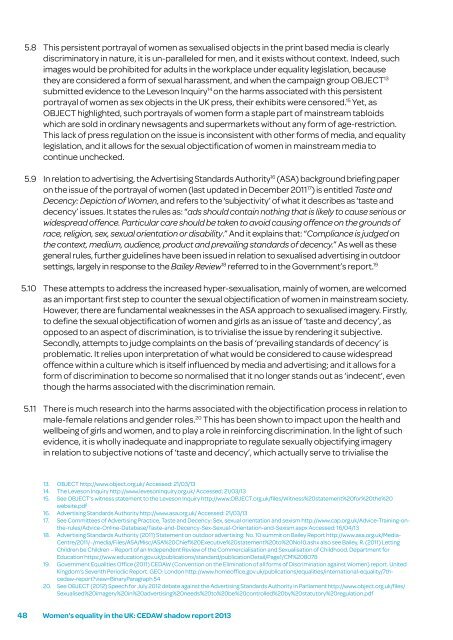Women’s equality in the UK – A health check
Women’s equality in the UK – A health check
Women’s equality in the UK – A health check
You also want an ePaper? Increase the reach of your titles
YUMPU automatically turns print PDFs into web optimized ePapers that Google loves.
5.8<br />
5.9<br />
5.10<br />
5.11<br />
This persistent portrayal of women as sexualised objects <strong>in</strong> <strong>the</strong> pr<strong>in</strong>t based media is clearly<br />
discrim<strong>in</strong>atory <strong>in</strong> nature, it is un-paralleled for men, and it exists without context. Indeed, such<br />
images would be prohibited for adults <strong>in</strong> <strong>the</strong> workplace under <strong>equality</strong> legislation, because<br />
<strong>the</strong>y are considered a form of sexual harassment, and when <strong>the</strong> campaign group OBJECT 13<br />
submitted evidence to <strong>the</strong> Leveson Inquiry 14 on <strong>the</strong> harms associated with this persistent<br />
portrayal of women as sex objects <strong>in</strong> <strong>the</strong> <strong>UK</strong> press, <strong>the</strong>ir exhibits were censored. 15 Yet, as<br />
OBJECT highlighted, such portrayals of women form a staple part of ma<strong>in</strong>stream tabloids<br />
which are sold <strong>in</strong> ord<strong>in</strong>ary newsagents and supermarkets without any form of age-restriction.<br />
This lack of press regulation on <strong>the</strong> issue is <strong>in</strong>consistent with o<strong>the</strong>r forms of media, and <strong>equality</strong><br />
legislation, and it allows for <strong>the</strong> sexual objectification of women <strong>in</strong> ma<strong>in</strong>stream media to<br />
cont<strong>in</strong>ue un<strong>check</strong>ed.<br />
In relation to advertis<strong>in</strong>g, <strong>the</strong> Advertis<strong>in</strong>g Standards Authority 16 (ASA) background brief<strong>in</strong>g paper<br />
on <strong>the</strong> issue of <strong>the</strong> portrayal of women (last updated <strong>in</strong> December 2011 17 ) is entitled Taste and<br />
Decency: Depiction of Women, and refers to <strong>the</strong> ‘subjectivity’ of what it describes as ‘taste and<br />
decency’ issues. It states <strong>the</strong> rules as: “ads should conta<strong>in</strong> noth<strong>in</strong>g that is likely to cause serious or<br />
widespread offence. Particular care should be taken to avoid caus<strong>in</strong>g offence on <strong>the</strong> grounds of<br />
race, religion, sex, sexual orientation or disability.” And it expla<strong>in</strong>s that: “Compliance is judged on<br />
<strong>the</strong> context, medium, audience, product and prevail<strong>in</strong>g standards of decency.” As well as <strong>the</strong>se<br />
general rules, fur<strong>the</strong>r guidel<strong>in</strong>es have been issued <strong>in</strong> relation to sexualised advertis<strong>in</strong>g <strong>in</strong> outdoor<br />
sett<strong>in</strong>gs, largely <strong>in</strong> response to <strong>the</strong> Bailey Review 18 referred to <strong>in</strong> <strong>the</strong> Government’s report. 19<br />
These attempts to address <strong>the</strong> <strong>in</strong>creased hyper-sexualisation, ma<strong>in</strong>ly of women, are welcomed<br />
as an important first step to counter <strong>the</strong> sexual objectification of women <strong>in</strong> ma<strong>in</strong>stream society.<br />
However, <strong>the</strong>re are fundamental weaknesses <strong>in</strong> <strong>the</strong> ASA approach to sexualised imagery. Firstly,<br />
to def<strong>in</strong>e <strong>the</strong> sexual objectification of women and girls as an issue of ‘taste and decency’, as<br />
opposed to an aspect of discrim<strong>in</strong>ation, is to trivialise <strong>the</strong> issue by render<strong>in</strong>g it subjective.<br />
Secondly, attempts to judge compla<strong>in</strong>ts on <strong>the</strong> basis of ‘prevail<strong>in</strong>g standards of decency’ is<br />
problematic. It relies upon <strong>in</strong>terpretation of what would be considered to cause widespread<br />
offence with<strong>in</strong> a culture which is itself <strong>in</strong>fluenced by media and advertis<strong>in</strong>g; and it allows for a<br />
form of discrim<strong>in</strong>ation to become so normalised that it no longer stands out as ‘<strong>in</strong>decent’, even<br />
though <strong>the</strong> harms associated with <strong>the</strong> discrim<strong>in</strong>ation rema<strong>in</strong>.<br />
There is much research <strong>in</strong>to <strong>the</strong> harms associated with <strong>the</strong> objectification process <strong>in</strong> relation to<br />
male-female relations and gender roles. 20 This has been shown to impact upon <strong>the</strong> <strong>health</strong> and<br />
wellbe<strong>in</strong>g of girls and women, and to play a role <strong>in</strong> re<strong>in</strong>forc<strong>in</strong>g discrim<strong>in</strong>ation. In <strong>the</strong> light of such<br />
evidence, it is wholly <strong>in</strong>adequate and <strong>in</strong>appropriate to regulate sexually objectify<strong>in</strong>g imagery<br />
<strong>in</strong> relation to subjective notions of ‘taste and decency’, which actually serve to trivialise <strong>the</strong><br />
13. OBJECT http://www.object.org.uk/ Accessed: 21/03/13<br />
14. The Leveson Inquiry http://www.leveson<strong>in</strong>quiry.org.uk/ Accessed: 21/03/13<br />
15. See OBJECT’s witness statement to <strong>the</strong> Leveson Inquiry http://www.OBJECT.org.uk/files/Witness%20statement%20for%20<strong>the</strong>%20<br />
website.pdf<br />
16. Advertis<strong>in</strong>g Standards Authority http://www.asa.org.uk/ Accessed: 21/03/13<br />
17. See Committees of Advertis<strong>in</strong>g Practice, Taste and Decency: Sex, sexual orientation and sexism http://www.cap.org.uk/Advice-Tra<strong>in</strong><strong>in</strong>g-on<strong>the</strong>-rules/Advice-Onl<strong>in</strong>e-Database/Taste-and-Decency-Sex-Sexual-Orientation-and-Sexism.aspx<br />
Accessed: 16/04/13<br />
18. Advertis<strong>in</strong>g Standards Authority (2011) Statement on outdoor advertis<strong>in</strong>g: No. 10 summit on Bailey Report http://www.asa.org.uk/Media-<br />
Centre/2011/~/media/Files/ASA/Misc/ASA%20Chief%20Executive%20statement%20to%20No10.ashx also see Bailey, R. (2011) Lett<strong>in</strong>g<br />
Children be Children <strong>–</strong> Report of an Independent Review of <strong>the</strong> Commercialisation and Sexualisation of Childhood. Department for<br />
Education https://www.education.gov.uk/publications/standard/publicationDetail/Page1/CM%208078<br />
19. Government Equalities Office (2011) CEDAW (Convention on <strong>the</strong> Elim<strong>in</strong>ation of all forms of Discrim<strong>in</strong>ation aga<strong>in</strong>st Women) report. United<br />
K<strong>in</strong>gdom’s Seventh Periodic Report. GEO: London http://www.homeoffice.gov.uk/publications/equalities/<strong>in</strong>ternational-<strong>equality</strong>/7thcedaw-report?view=B<strong>in</strong>aryParagraph<br />
54<br />
20. See OBJECT (2012) Speech for July 2012 debate aga<strong>in</strong>st <strong>the</strong> Advertis<strong>in</strong>g Standards Authority <strong>in</strong> Parliament http://www.object.org.uk/files/<br />
Sexualised%20imagery%20<strong>in</strong>%20advertis<strong>in</strong>g%20needs%20to%20be%20controlled%20by%20statutory%20regulation.pdf<br />
48 <strong>Women’s</strong> <strong>equality</strong> <strong>in</strong> <strong>the</strong> <strong>UK</strong>: CEDAW shadow report 2013


